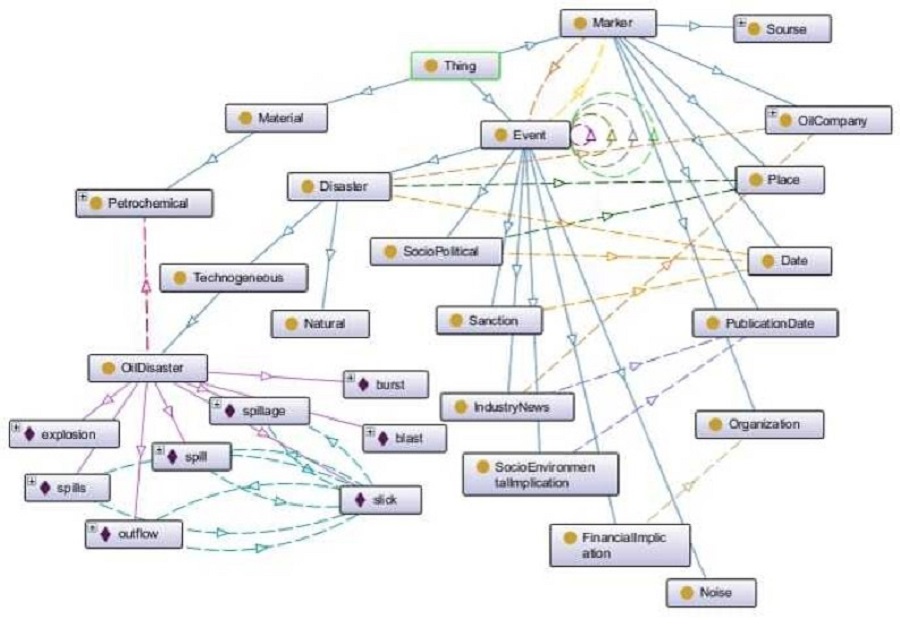Modification of the ontology using the teacher’s personal materials to increase the degree of automation of EC preparation
DOI:
https://doi.org/10.15587/1729-4061.2023.295091Keywords:
computer ontology, electronic textbooks, ontology description language, genetic algorithmAbstract
The object of the research is the technology of constructing a computer ontology (CO) for electronic textbooks of the subject area (KSA). As an example, the industry is considered-information and communication technologies (ICT) and the topic "databases".
The subject of the study are models and methods of automated construction of a CO of the KSA.
The methodology of modification of CO in the field of ICT is proposed by introducing into the formal computer ontology a description of the technologies of the learning process for secondary schools or extracurricular institutions, as well as for professional retraining of specialists, which allows preserving and reusing the collective experience of learning in an educational institution.
The proposed solution differs from the existing ones in that the system of ontologized design of electronic courses (SODEC). It allows to automate the development of electronic courses (EC) and / or electronic textbooks (ET), reduces the cost and time of preparing ET, ensures compliance of EC with the current state in the field of ICT. As an example, the design section of ET for the topic "databases" is considered. The proposed solution allows to accumulate personal materials of the teacher and contributes to the rapid updating of the content and content of ET, if necessary. It is concluded that for more effective use of the proposed methodology, it is necessary to develop a similar SODEC, taking into account the language of description of CO – OWL, which will allow to accumulate collective experience in the methods of submitting material to teachers of educational institutions or extracurricular institutions, as well as during professional retraining of specialists
References
- Palagin, A., Kryvyi, S., Petrenko, N. (2012). Ontological methods and means of processing subject knowledge. Luhansk, 324.
- How E-learning Works. Available at: https://www.mindmeister.com/ru/276895070/how-e-learning-works-by-lee-ann-obringer-mind-map-presentation-created-by-nathaniel-imperial
- Sabitova, N. Zh., Razakhova, B. Sh., Taimuratova, L. U., Tikhonov, Y., Lakhno, V., Shuakbayeva, R. S. et al. (2023). The use of ontological modeling in the preparation of electronic courses in the field of information and communication technologies. Journal of Theoretical and Applied Information Technology, 101 (15), 5999–6013. Available at: http://www.jatit.org/volumes/Vol101No15/12Vol101No15.pdf
- Guraliuk, A., Rostoka, M., Koshel, A., Skvorchevska, Y., Luchaninova, O. (2022). Ontological Modeling of Electronic Educational Resources. Lecture Notes in Networks and Systems, 661–668. doi: https://doi.org/10.1007/978-3-030-93907-6_71
- Ataeva, O. M., Serebryakov, V. A., Tuchkova, N. P. (2022). Creating the Applied Subject Area Ontology by Means of the Content of the Digital Semantic Library. Lobachevskii Journal of Mathematics, 43 (7), 1795–1804. doi: https://doi.org/10.1134/s1995080222100043
- Jensen, J. (2017). A systematic literature review of the use of Semantic Web technologies in formal education. British Journal of Educational Technology, 50 (2), 505–517. doi: https://doi.org/10.1111/bjet.12570
- Tikhonov, Yu. L. (2017). Tool for formation of electronic course. Podilian Bulletin: Agriculture, Engineering, Economics, 27, 220–225. Available at: http://pb.pdatu.edu.ua/article/view/135318
- Tikhonov, U., Lakhno, V., Skliarenko, E., Stepanenko, O., Dvirnyi, K. (2016). Development of ontological approach in e-learning when studying information technologies. Eastern-European Journal of Enterprise Technologies, 5 (2 (83)), 13–20. doi: https://doi.org/10.15587/1729-4061.2016.79230
- Hitzler, P., Gangemi, A., Janowicz, K., Krisnadhi, A. A., Presutti, V. (Eds.) (2016). Ontology engineering with ontology design patterns: foundations and applications. Vol. 25. IOS Press, 388.
- Kendall, E. F., McGuinness, D. L. (2019). Ontology engineering. Springer Cham, 102. doi: https://doi.org/10.1007/978-3-031-79486-5
- Almagambetova, A. A., Tileubay, S. S., Taimuratova, L. U., Seitmuratov, A., Kanibaikyzy, K. (2019). Problem on the distribution of the harmonic type relay wave. NEWS of National Academy of Sciences of the Republic of Kazakhstan, 1 (433), 242–247. doi: https://doi.org/10.32014/2019.2518-170x.29
- Niyazova, R., Aktayeva, Al., Davletkireeva, L. (2019). An ontology based model for user profile building using social network. Proceedings of the 5th International Conference on Engineering and MIS. doi: https://doi.org/10.1145/3330431.3330453

Downloads
Published
How to Cite
Issue
Section
License
Copyright (c) 2023 Nazym Sabitova, Yuriy Tikhonov, Valerii Lakhno, Rosamgul Niyazova, Bibigul Razakhova, Sholpan Zholdasova, Tleugaisha Ospanova, Lidiya Taimuratova

This work is licensed under a Creative Commons Attribution 4.0 International License.
The consolidation and conditions for the transfer of copyright (identification of authorship) is carried out in the License Agreement. In particular, the authors reserve the right to the authorship of their manuscript and transfer the first publication of this work to the journal under the terms of the Creative Commons CC BY license. At the same time, they have the right to conclude on their own additional agreements concerning the non-exclusive distribution of the work in the form in which it was published by this journal, but provided that the link to the first publication of the article in this journal is preserved.
A license agreement is a document in which the author warrants that he/she owns all copyright for the work (manuscript, article, etc.).
The authors, signing the License Agreement with TECHNOLOGY CENTER PC, have all rights to the further use of their work, provided that they link to our edition in which the work was published.
According to the terms of the License Agreement, the Publisher TECHNOLOGY CENTER PC does not take away your copyrights and receives permission from the authors to use and dissemination of the publication through the world's scientific resources (own electronic resources, scientometric databases, repositories, libraries, etc.).
In the absence of a signed License Agreement or in the absence of this agreement of identifiers allowing to identify the identity of the author, the editors have no right to work with the manuscript.
It is important to remember that there is another type of agreement between authors and publishers – when copyright is transferred from the authors to the publisher. In this case, the authors lose ownership of their work and may not use it in any way.









